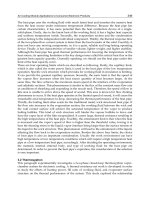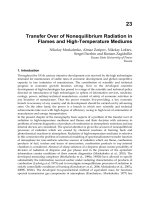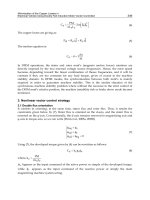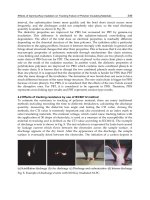Build A Remote-Controlled Robot part 13 pdf
Bạn đang xem bản rút gọn của tài liệu. Xem và tải ngay bản đầy đủ của tài liệu tại đây (161.37 KB, 10 trang )
robot’s framework so the five tabs sit on top of the panel. Mark
the panel where the holes on the tabs rest, then remove it and
drill 1/8-inch-diameter holes where marked. Now when you
place the panel on top of the tabs, the holes should line up and
the panel can be screwed in place. To complete the panel,
cover it with aluminum tape. Two 6-inch wide strips running
the length of the panel will be enough to cover its front surface
and edges. Figure 6-4 shows the completed panel installed.
88 CHAPTER SIX
FIGURE 6-2. Mounting tab for rear access panel.
FIGURE 6-3. Tab in place on framework.
The access panels that cover the top of Questor’s lower
framework are made and mounted in the same way as the rear
panel. These two U-shaped panels when pieced together form a
ring around the upper framework and cover the openings of the
lower. The measurements for the panels are shown in
Fig. 6-5. The panels are held in place by the same type of metal
tab system used for the rear panel. In this case, however, you
SKIN AND FINISHING TOUCHES 89
FIGURE 6-4. Completed rear access panel.
will need two 2-inch- and two 1-inch-long tabs. The tabs are
screwed to the lower framework using 1/8-inch sheet metal
screws rather than rivets; I made this decision because I felt it
looked better. You, however, could rivet them if you wish. There
are predrilled holes along the top of the lower framework where
the tabs should be attached. The two 2-inch tabs go on the
sides of the frame, while the 1-inch tabs go on the front and
rear. Figure 6-6 shows where the tabs are located.
Drilling the mounting holes in both panels and tabs so that
they line up, is handled differently from the rear panels. Place
the two panels so that they sit flush on the mounting tabs. If
the panels go past the inside of the top of the lower frame-
work, trim the edges of the panels until they both fit inside
the framework and sit flush on the mounting tabs; now mark
on the panels where they sit on the tabs. The two 1-inch tabs
will have one hole a piece, while the two 2-inch tabs will have
two holes at either end of the two panels where they both sit
on the one tab. Figure 6-7 illustrates where 1/8-inch mount-
ing holes will be drilled at the same time in both panels and
90 CHAPTER SIX
FIGURE 6-5. U-shaped access panel for lower framework.
the tabs. Cover the panels with aluminum tape and fasten
them to the tabs with 1/8-inch sheet metal screws.
Now that all the openings on Questor’s body are covered,
it is time to mount the robot’s serving tray, lower body lights,
and controls previously wired to the robot.
MOUNTING TRAY
The next item to be mounted to Questor is his serving tray. If
you haven’t already, reattach Questor’s arm and reinstall his
drink dispenser system. The tray itself is a 17 1/2- ϫ 12 3/4-
inch snack tray like that pictured in Fig. 6-8. Place the tray
across the arms and mark on the tray where the corners sit on
the arms. Drill four 1/4-inch-diameter holes in the tray and sit
it back on the arms. Align the tray so it sits straight and mark
the holes in the tray on the arms. Drill four 1/4-inch-diameter
holes in the arms and screw the tray in place with four 1/4-
inch-diameter metal screws. Also at this time you’ll be attach-
ing Questor’s hands that you made previously.
SKIN AND FINISHING TOUCHES 91
FIGURE 6-6. Tabs for lower access panels.
MOUNTING CONTROLS
Eight previously installed components are now mounted on
Questor’s body panels. The first three are the two speed con-
trollings pots and the main power switch of the robot’s motor-
ized platform. These components are mounted on the rear
panel of the lower framework on either side of the motor for the
vacuum system. Figure 6-9 shows where the components are
located. The second switch seen on the rear panel is for the two
headlights that will be mounted on the front of the lower panel
92 CHAPTER SIX
FIGURE 6-7. Hole in both access panel and mounting tab.
SKIN AND FINISHING TOUCHES 93
FIGURE 6-8. Serving tray and hands in place.
FIGURE 6-9. Location of components mounted earlier (pots, on/off switch, and
charging plugs).
later in this chapter. Also note the rubber gasket around the
vacuum cleaner motor that you can attach at this time.
To mount the pots and switches, poke a hole through
the front of the panel folding the excess sheet metal against
the inside of the panel. It is then a simple matter to mount
the components in place by attaching them to the panels
using the nuts that come with both the switches and pots.
You can, if you wish, buy knobs for the pots, but it is not
necessary.
Also mounted on the rear panel of the lower framework
are the two charging plugs for Questor’s batteries. These
plugs needed a firmer base than the metal flashing can pro-
vide. For this reason two 6-inch strips of aluminum angle are
riveted vertically at either side of the framework behind the
body panel. The plugs are then fitted between the side of the
framework and the support strip utilizing a ridge that goes
around the plug. A small square must be cut in the lower
corner on either side of the panel to accommodate the plug
as seen in Fig. 6-10.
The next two items are the on/off switch and recharge
plugs for the remote control system. The on/off switch is
mounted at the lower edge of the right side panel of the upper
framework. Follow the mounting directions that come with
the RC system and use the hardware that comes with the
switch. The RC charging plug is taped to the lower edge of the
back framework itself; I used duct tape because it had a
metallic look that matched the framework. Both mountings
are shown in Figs. 6-11 and 6-12.
The last item to be mounted is the on/off switch for the
auto dome light in Questor’s head. Mount it on the same side
as the on/off switch for the RC system, but at the top edge of
the framework, as shown in Fig. 6-13.
Once these eight components have been mounted,
Questor is basically complete. The rest of this chapter is
devoted to adding items to spruce up the robot’s appearance.
Also, if you have purchased an RC system with a third channel,
you will be adding a horn that is controlled by the system’s
third servo.
94 CHAPTER SIX
95
FIGURE 6-10. Charging plug in place.
FIGURE 6-11. RC on/off switch mounting.
BODY LIGHTS AND HORN
Questor’s headlights are two 12-volt auto courtesy lights
mounted on the front of the lower framework positioned at
either side of the vacuum cleaner port. You mount the lights
96 CHAPTER SIX
FIGURE 6-12. RC charging plug.
FIGURE 6-13. On/off button for dome light.
the same way as the switches mounted earlier, but cut out the
extra metal instead of folding it in. Follow the mounting direc-
tions for the lights you have obtained. Figure 6-14 shows how
to wire the lights. The control switch for the lights (an SPST
switch you must supply) is mounted on the rear of the lower
framework on the opposite side of the vacuum cleaner motor
from the main power switch.
Questor’s 12-volt horn is mounted on the bottom of the
upper framework’s front panel; it is then wired to the RC
motherboard that, if you opted, should already have the con-
trol leaf switch wired in place. Mount the horn on the front of
the robot somewhere and connect the red wire of the horn to
terminal number 14 on the RC motherboard, and the black
lead to the negative power grid. To control the horn, move one
of the control sticks on the RC transmitter sideways. This will
cause the third servo on the motherboard to turn, activating
the leaf switch controlling the horn. A second leaf switch
mounted on the opposite side of the servo is used to control
any other on/off function you wish. Both the horn and lights
are shown in Fig. 6-15 mounted in place.
SKIN AND FINISHING TOUCHES 97
FIGURE 6-14. Courtesy light wiring diagram.









